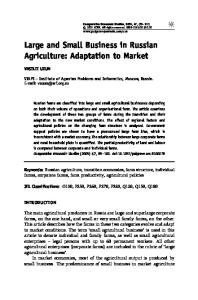The Allocative Efficiency of Material Input Use in Russian Agriculture
- PDF / 105,243 Bytes
- 10 Pages / 441 x 666 pts Page_size
- 81 Downloads / 302 Views
www.palgrave-journals.com/ces
The Allocative Efficiency of Material Input Use in Russian Agriculture WILLIAM M. LIEFERT1 Economic Research Service, US Department of Agriculture, Washington, DC, USA. E-mail: [email protected]
This paper examines the allocative efficiency of use of material inputs, and fertiliser in particular, in Russian agriculture during the transition from a planned to a market economy. The results indicate that inputs in the aggregate are overused (their purchase price exceeding the value of their marginal product), though fertiliser is underused. The findings support the argument that the substantial drop in agricultural input use during transition has been economically rational. Comparative Economic Studies (2005) 47, 214–223. doi:10.1057/palgrave.ces.8100086
Keywords: Russian agriculture, transition economies, farm inputs, fertiliser, efficiency JEL Classifications: D610, P230, Q180
During Russia’s transition from a planned to a market economy, the volume of material inputs used in agriculture has declined severely. From 1990 to 2002, use of mineral fertiliser, other soil-enhancing chemicals (such as lime), and gasoline all fell by over 80 percent, while use of electricity decreased by about two-thirds. This article examines the allocative efficiency of the use of material inputs, and fertiliser in particular, during the transition period. The results are then used to assess whether the large drop in input use has been economically rational.
1
The author thanks Zvi Lerman for helpful comments, and bears responsibility for any remaining deficiencies. The views expressed are the author’s alone and do not in any way represent official USDA views or policies.
WM Liefert Allocative Efficiency of Input Use in Russian Agriculture
215
METHODOLOGY AND DATA We assess the allocative efficiency (AE) of input use by comparing the price of input i (Pi) with the value of its marginal product in producing commodity j (VMPji). If Pi>(o) VMPji, the farm should decrease (increase) the use of input i in order to improve allocative efficiency (and profit). We accordingly present the results of AE analysis in terms of the AE ratio, which is calculated as the ratio of VMPji to Pi: when the AE ratio is less than 1, the input’s use should be reduced; when the AE ratio is greater than 1, the input’s use should be increased. All marginal product estimates used in the AE tests are from econometrically estimated generalized Cobb-Douglas functions explaining the value of farm output. For each output/input combination, multiplying the estimated coefficient in the Cobb-Douglas function by the (geometrical) mean product of the input gives the input’s estimated VMP (the methodology of AE analysis is briefly summarised by Grazhdaninova and Lerman, 2005). This article provides a summary overview of the AE calculations carried out by various researchers as part of the BASIS Russia project.2 We only report the AE results for use of material inputs – fertiliser, seeds, animal feed, fuel, electricity, spare parts, and s
Data Loading...











